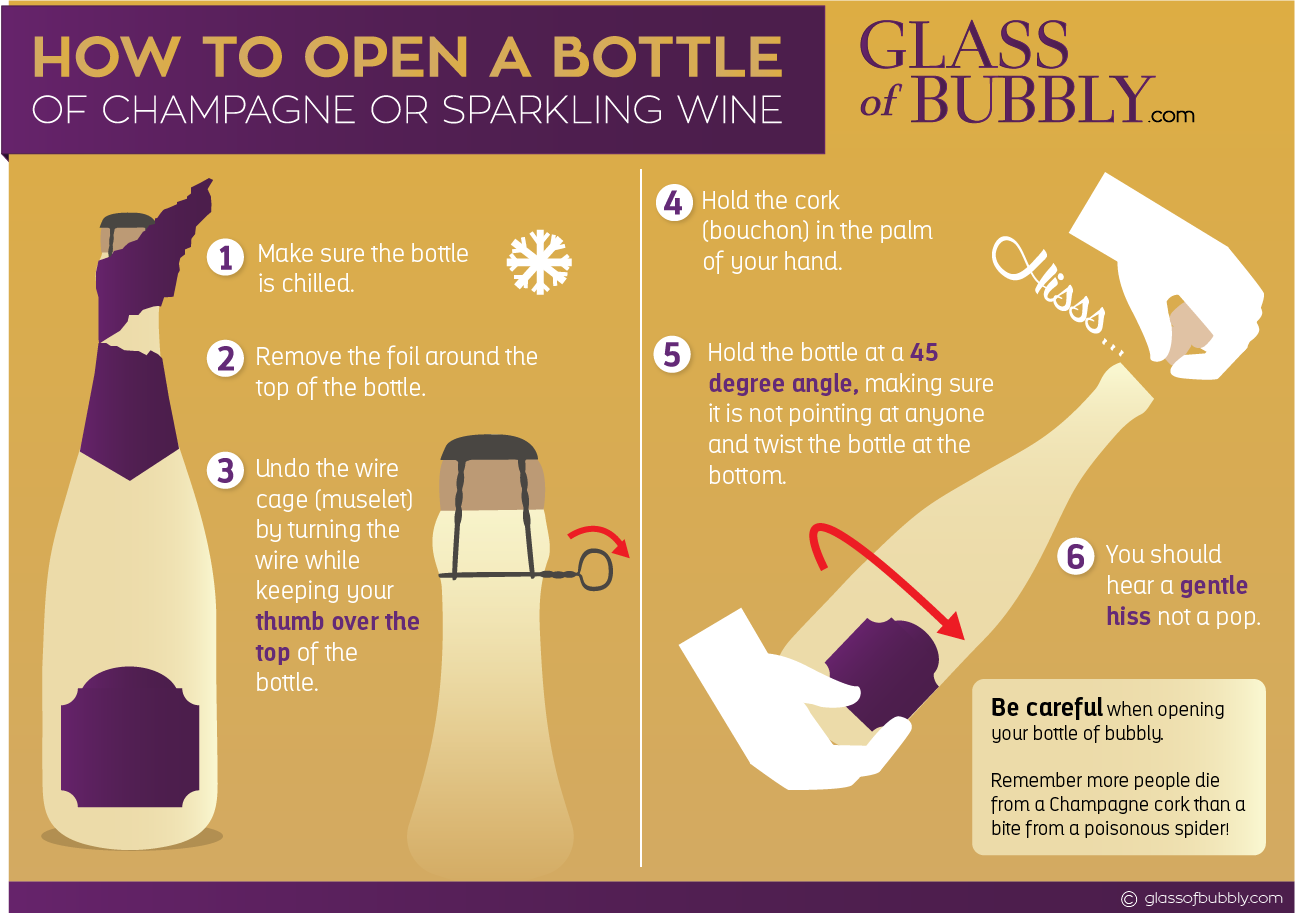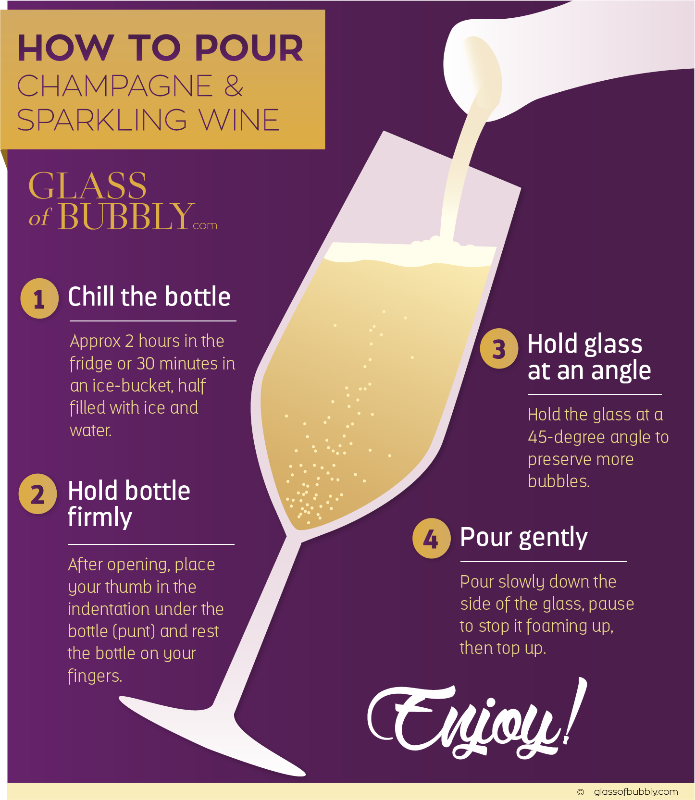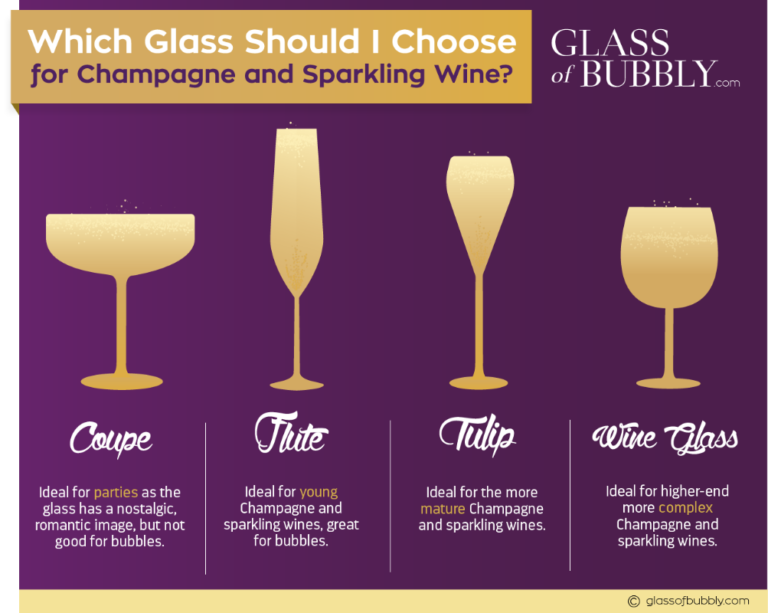How to Open & Serve Champagne or Sparkling Wine
September 12, 2023It’s New Year’s Eve and your guests are about to arrive when you go to pull your bottle of bubbly from the fridge and think… “I have no idea how to serve this Sparkling Wine or Champagne” or even, “How the heck do I even open this thing”. Worry not, we have all the tips and tricks for you to enjoy your favorite bubbly, because we all know hearing the pop of a champagne cork is the universal sound of happy!
We have compiled a list of common mistakes people make when serving sparkling wine, and then we have a few infographics from Glass of Bubbly.com to give you real visuals to give you the best Sparkling wine experience.
Grab your own bottle of Brut Rosé or Blanc de Blanc and follow along for the perfect pour of bubble bliss. Use this code for “LGCPROMO” for 15% off your first purchase.

Watch our video below as we demonstrate how to properly and safely open a bottle of champagne or sparkling wine.
THE TEMPERATURE
Store the bottle in the fridge the night before, storing your wine in the fridge for too long can dry out the cork and alter the taste due to lack of humidity. Once out of the fridge let it sit out and warm up naturally to the ideal cellar temperature which is around 55 degrees. When wine gets to this temperature all the aromas come out and you can really pick apart the different flavors in the wine.
THE CORK
We know it looks really cool to pop the cork, but if you want to look like a true professional, take off the cage, put a cloth over the cork and your thumb on top, then gently twist the bottle until the cork is out (quietly) and without the load *pop*. That said, we always say the pop of the cork is the universal sound of happy, and well, it’s hard to resist as it sets the scene and makes people smile.

TILTING THE GLASS
The reason you pour at 45-degree angle is so that the bubbles will hit a larger surface area of the glass, and it will reduce overfill and the bubbly over effect.
HOW MUCH TO POUR
Pro tip: if you only fill your glass halfway, you will always have cold bubbles and never have to worry about overfill. We are fans of super chilled bubbly so refill often vs topping it off.

TYPE OF GLASS
While the typical champagne flute is the go-to for Sparkling wine in America, it actually represses the aroma of the wine by having such a narrow top, so if you want to enjoy your wine, opt for a wider top.
In Italy Sparkling Wine is served in a white wine glass. This is because just like still wine, the more sparkling wine breathes, the more expressive it becomes on your palette.
The coupe is always a classic and evokes a nostalgia of a bygone era. Rumor has it by some that it was modeled after Marie Antoinette’s breast – she drank copious (our coup-ious pun intended) amounts of the bubbles and had a flair for the extravagant.
We find that the Tulip is a nice compromise or mid-point between the glass styles and offers a nice elegance and a wider mouth.
THE GLASS AND ITS IMPACT ON THE BUBBLES
The bubbles are a naturally occurring feature in the bottle due to the secondary fermentation and the carbon dioxide which builds up and doesn’t escape since it is under pressure. That said, the abundance of bubbles in a glass is enhanced by the nucleation points which occur from contact with the glass. Thus, the greater the surface area of glass, the greater the impact on the bubbles.
The nucleation points are small defects in the glass that trap tiny vibrating pockets of carbon dioxide. Dissolved gas in the champagne or sparkling gradually collects in a vibrating bubble inside the defect, causing it to grow and soon expel gas from the defect, forming another bubble that sticks to the outside of the defect.
Additionally, micro-fibers from dish clothes used to buff the glasses and such also can form and create or entrap a tiny air pocket when Champagne is poured,” said physicist Gerard Liger-Belair. “Then, this tiny air pocket literally sucks the [dissolved] carbon dioxide.” The gas bubbles grow inside the fibers, detaching from them once they reach the tip of a fiber.
See other ways you can use your leftover Sparkling wine with our DIY Sparkling Wine Spa Treatments!
More Blogs
- Sip, Savor, & Socialize: Elevate Your Evening with These 3 Low ABV Sparkling Wine Cocktails
- Brunch: The Rise of the New Dinner Party Experience + 3 Tips For Bubbly Brunch Entertaining
- Easy & Fun Champagne Cocktail Garnishes That Upgrade Your Sparkling Wine & the Party
- Elevate Your Game Day | 32 Favorite and Unique Sports Party Pairings | Appetizers To Go With Sparkling Wine & Champagne
- 45 Fun Ways To Celebrate Galentine’s Day & Valentine’s Day | Unique Wine Themed Valentine & Galentine Activities
- Songs About Champagne & Why It’s Not JUST For NYE! | Wine Lifestyle Tips
- Romantic Date Night with Champagne** or Sparkling Wine
- Win A Trip To Paris + Taylor Swift Eras Tickets + Guide To Exploring Paris
- Best Thanksgiving Wine For Pouring, Pairing, & Fall Cocktail Mixing | Eight Reasons Rosé Shines In Autumn
- Taylor Swift Eras That Pair Well With French Wines | Throw A Taylor Swift Movie Premiere Party!
